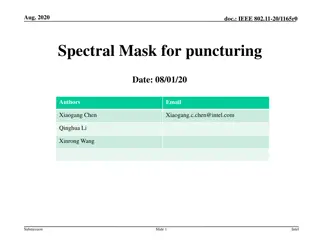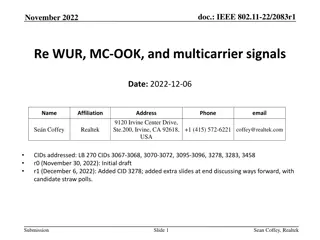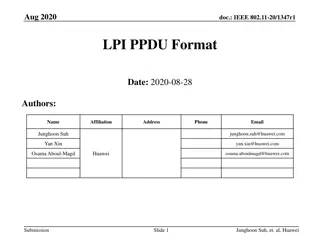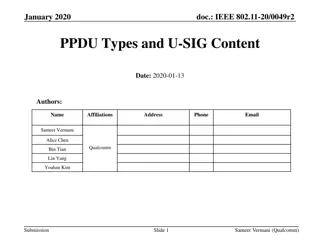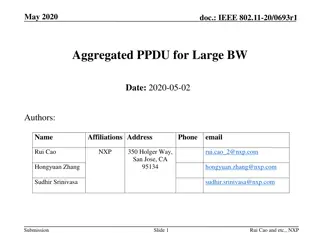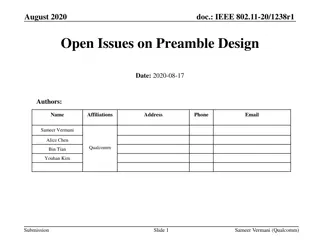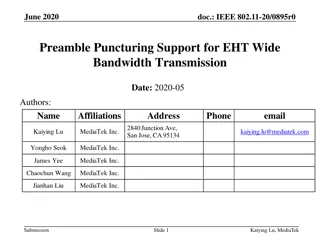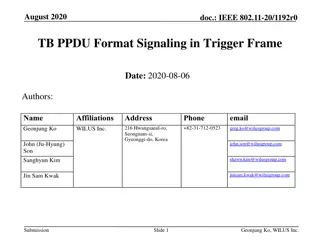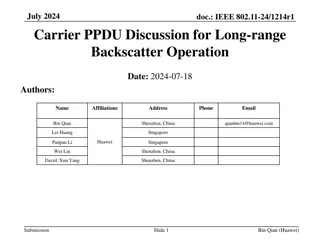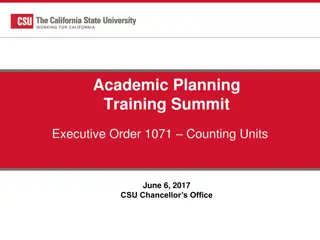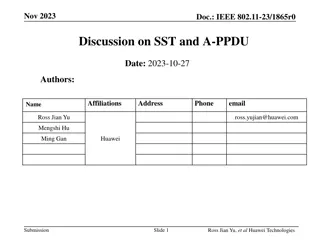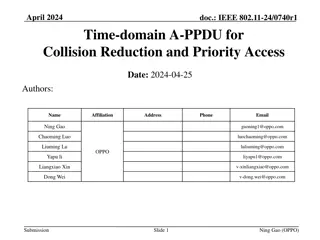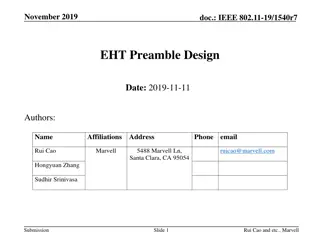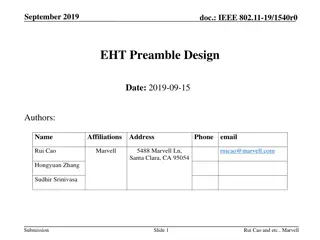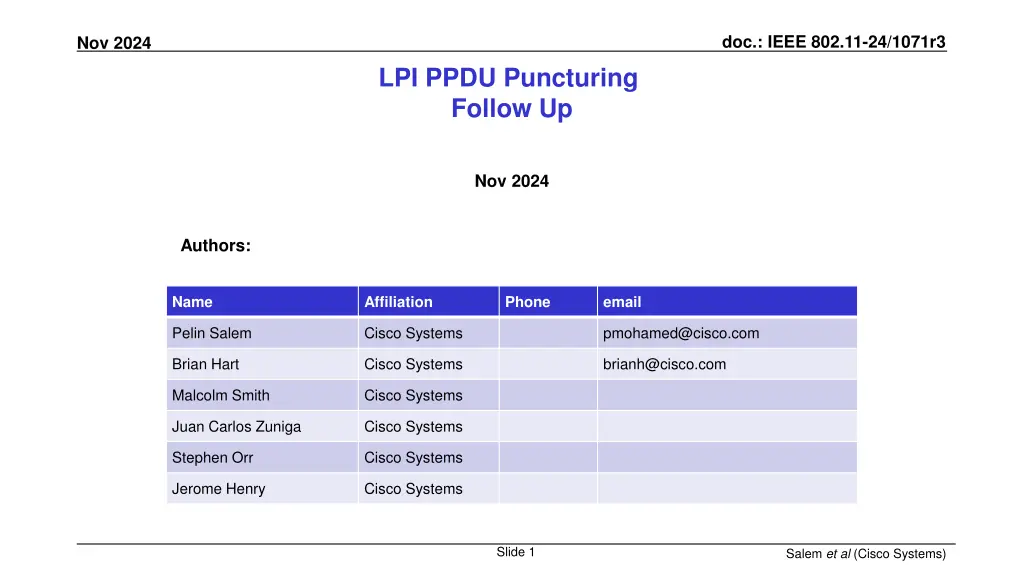
Composite APs Interoperability Solutions in IEEE 802.11-24/1071r3 Nov. 2024
Explore the industry's quest for pervasive interoperability among clients with Simultaneous Composite APs, addressing FCC regulations and challenges faced by LPI-only and SP-only devices. Delve into the requirements and limitations of Simultaneous Composite APs in providing seamless communication across different client types.
Download Presentation

Please find below an Image/Link to download the presentation.
The content on the website is provided AS IS for your information and personal use only. It may not be sold, licensed, or shared on other websites without obtaining consent from the author. If you encounter any issues during the download, it is possible that the publisher has removed the file from their server.
You are allowed to download the files provided on this website for personal or commercial use, subject to the condition that they are used lawfully. All files are the property of their respective owners.
The content on the website is provided AS IS for your information and personal use only. It may not be sold, licensed, or shared on other websites without obtaining consent from the author.
E N D
Presentation Transcript
doc.: IEEE 802.11-24/1071r3 Nov 2024 LPI PPDU Puncturing Follow Up Nov 2024 Authors: Name Affiliation Phone email Pelin Salem Cisco Systems pmohamed@cisco.com Brian Hart Cisco Systems brianh@cisco.com Malcolm Smith Cisco Systems Juan Carlos Zuniga Cisco Systems Stephen Orr Cisco Systems Jerome Henry Cisco Systems Slide 1 Salem et al (Cisco Systems) -
doc.: IEEE 802.11-24/1071r3 Nov 2024 The industry is seeking that Simultaneous Composite APs (Indoor SP APs) provide pervasive interoperability for all clients FCC s 6 GHz regulations and KDBs created silos LPI-only clients can t talk to SP APs SP-only clients can t talk to LPI APs Outdoor APs can only be SPs The hope/expectation was that all clients be dual certified and could talk to any AP But, with early roll-out of LPI-only APs and clients, that hasn t happened and continues to not happen The second and most promising solution to have pervasive interoperability is the Simultaneous Composite AP See next slide Slide 2 Salem et al (Cisco Systems) -
doc.: IEEE 802.11-24/1071r3 Nov 2024 Simultaneous Composite APs Support All Client Flavors (USA) for UNII5/7 control channels AFC System (Unchanged) Required Simultaneous Composite (LPI+SP) AP Wired power, not battery powered, integrated antenna, enclosure not weatherized, conspicuously labelled that FCC regulations restrict operation to indoor use only. Authorized to transmit at max(LPI, SP) power on UNII5/7, Changes to LPI AP on UNII6/8 6PP (Sub-ordinate) client 6XD (LPI-only) client Can use Subordinate power limits Can use LPI client power limits 6FX (SP-only) client 6VL (VLP-only) device 6FC (Fixed) client 6CD (Dual) client Can use VLP power limits Can use max(LPI, SP) client power limits Can use SP client power limits (6 dB below limits provided by AFC System) Obtains its power limits from the AFC System Client can connect/associate to AP -
doc.: IEEE 802.11-24/1071r3 Nov 2024 However, although allowed for SP APs, PPDU puncturing is currently not allowed for LPI APs In April 2020, 6GHz LPI was allowed by regulators (indoor only, low power limits, Contention-Based- Protocol (CBP) requirement) Over 2017-2023, IEEE 802.11ax/be defined PPDU puncturing via preamble puncturing and OFDMA (then Multi-RUs) It was assumed that PPDU puncturing could be used in LPI BSSs at 6 GHz to avoid all kinds of interference (incumbents, other unlicensed users) In August 2023, FCC completely disallowed PPDU Puncturing by LPI BSSs as per 987594 D02 U-NII 6 GHz EMC Measurement v02r01 In October 2023, FCC relaxed this a little for LPI BSSs, but only for network optimization purposes. E.g., To avoid other Wi-Fi systems; but not to avoid incumbents (here, licensed users) Slide 4 Salem et al (Cisco Systems) -
doc.: IEEE 802.11-24/1071r3 Nov 2024 Thus, Simultaneous Composite APs (Indoor SP APs) are not (yet) providing the characteristics that the industry seeks When LPI power > SP power, the Simultaneous Composite AP chooses to operate as an LPI AP, and it is not allowed to perform preamble puncturing around incumbents Preamble Puncturing provides valuable spectrum gains (see slides 6-7 and back-up slides 19-22) For the Simultaneous Composite AP to achieve its goal of providing a complete and perfect replacement to LPI-only and SP-only AP operation, we need to enable preamble puncturing around incumbents See [1] for a previous, broader solution, but here we show a simpler and sufficient solution // This problem remains even if regulations allow LPI APs to have higher power Slide 5 Salem et al (Cisco Systems) -
doc.: IEEE 802.11-24/1071r3 Nov 2024 Guide for the Following Slide Please find below a brief guide to clarify the graphics in the following slide and additional similar slides in the back-up. A-B-C-D(-E-F-G-H) = Each represent a 20MHz subchannel within the main 80/160MHz channel I = Location of incumbent within 20 MHz (e.g., "I I I" indicates a lower, middle or upper location) Green = Usable subchannel Yellow = Tentative use subchannel (usable depending on the exact location of the incumbent within the 20MHz channel) White/blank = Unusable subchannel Orange = Subchannel where incumbent is present P = Primary channel S = Secondary channel Center graph = Channel map Left graph = Channel map with non-punctured scenario Right graph = Channel map with punctured scenario AP/RRM system gets to pick the row(s) = AP will decide on which subchannel to be used as primary channel Punctured scenario B C D A Non-punctured scenario B C D A B C D P S S A I I P P S S S or P S S I I I or P or S P S S or I I S P S I or P S or S S P S or S P S I I I I or S P or S S S P or I I S S P I I I or S S P I Slide 6 Salem et al (Cisco Systems) -
doc.: IEEE 802.11-24/1071r3 Nov 2024 The Problem with Not Having Puncturing and the Benefit of Having It (Mid of 160MHz) Consider the simple 160 MHz bandwidth case below. An incumbent arrives and is detected via a DFS-like process or channel utilization analysis; LPI BSS can enable puncturing for that 20MHz subchannel for network optimization purposes IFF the interference is due to Wi-Fi (or another unlicensed technology) and not due to an incumbent. This requires higher level of processing compared to simple CCA. If the Incumbent appears on subchannel D, up to 140 MHz out of 160MHz can be used; depending on the exact location of the incumbent, perhaps 1-2 adjacent channels are unusable too (pale yellow). With puncturing based on behavior acceptable to regulators, we can convert most BSSs to 140 MHz BSSs or close to that Non-punctured scenario A B C E F G H D Punctured scenario P S I I I A B C E F G H D A B C E F G H D or S P I I I or P S S S S S S I P S S S S S S S or P I or P S S S S S S I or S P S S S S S S or P I I or P S S S S S S I * AP/RRM system gets to pick the row(s) or S S P S S S S S or P S S S I I or S P S S S S S I I I or S S S P S S S S or SPSS, etc I I or S S P S S S S I I I or S S S S P S S S or P S S S I or S S S P S S S I I I or S S S S S P S S or S P S S I or S S S S P S S I I I or S S S S S S P S or S S P S I or S S S S S P S I I I or S S S S S S S P or S S S P I or S S S S S S P I I I or P S I I I (Note simplified consideration of incumbent bandwidth after the first three rows) or S P I I I Slide 7 Salem et al (Cisco Systems) -
doc.: IEEE 802.11-24/1071r3 Nov 2024 Solution Use AFC info and IEEE Tx PSD mask Regulators disallowed PPDU puncturing for LPI BSSs because the LPI BSS has no information about incumbents However, a Simultaneous Composite AP when operating in LPI mode still has AFC connectivity. Then, we have a new choice (backwards compatible; no new signaling and no impact on non-AP STAs): AP in LPI mode inspects AFC response, and, as usual, itself does not exceed the PSD permitted by the AFC for APs. The AP also reports to non-AP STAs their AFC-permitted powers in the punctured channels via the TPE elements Current TPEs for a composite AP include max(LPI, SP). However, for a channel punctured due to an incumbent (and without CCA), LPI is not applicable, so AP just reports permitted SP power (new behavior). However, REVme-aware LPI clients don t follow the TPE elements sent by a Simultaneous Composite AP today (they rely on their own regulatory knowledge) so this is not a sufficient solution As well, the AP needs to help ensure LPI clients will meet their regulations Knowing that LPI clients sending punctured PPDUs always need to meet the IEEE punctured mask (>=-20 dBr over most of punctured region), even at their maximum LPI power of -1 dBm /MHz; so -1 dBm/MHz 20 dBm = -21 dBm/MHz. Thus, if the AFC-defined notch is above -21 dBm/MHz for a non-AP STA, then the AP may enable puncturing in Simultaneous Composite AP mode (i.e., even for LPI clients) Conversely, if the AFC-defined notch is below -21 dBm/MHz within the punctured region, then the AP cannot help ensure LPI clients will meet their regulations. Still, this is now a tolerably minor corner case. AP might a) reduce BW to avoid puncturing, b) change to SP-only mode, c) stop the BSS, etc. Example AFC response LPI power with CCA 20 dB IEEE punctured TX PSD mask Here we anticipate that LPI punctured operation can be allowed LPI power with CCA 20 dB IEEE punctured TX PSD mask Here the S.C. AP cannot enable punctured operation Slide 8 Salem et al (Cisco Systems) -
doc.: IEEE 802.11-24/1071r3 Nov 2024 Summary We want the Simultaneous Composite AP: To provide service to every class of clients To have every 802.11 feature available, including PPDU puncturing FCC currently does not permit PPDU Puncturing in LPI BSSs as an allowed method to protect incumbents If an incumbent occupies the upper or lower half of an 80 MHz channel, the LPI BSS bandwidth drops to 40 MHz If an incumbent occupies the upper or lower half of a 160 MHz channel, the LPI BSS bandwidth drops to 80 MHz However, we see good prospects for FCC allowing PPDU puncturing by LPI APs and clients in the BSSs of Simultaneous Composite APs as long as the AFC response for the punctured channel(s) exceeds the maximum power that LPI APs and clients transmit in the punctured channel No new protocol is required; just new AP behavior and its TPE element contents Slide 9 Salem et al (Cisco Systems) -
doc.: IEEE 802.11-24/1071r3 Nov 2024 Strawpoll Do you agree to add the following text to the 11bn SFD: 11bn shall define a mode of operation whereby a Simultaneous Composite AP in BSS can use its knowledge of AFC-provided regulatory limits and the punctured IEEE Tx PSD mask to enable PPDU Puncturing even for LPI-only non-AP STAs, via changes to the TPE elements contents that ensure compliance to the AFC- provided regulatory limits. Y / N / A Slide 10 Salem et al (Cisco Systems) -
doc.: IEEE 802.11-24/1071r3 Nov 2024 Reference [1] 24/0534, LPI Static Preamble Puncturing , Pelin Salem (Cisco Systems) Slide 11 Salem et al (Cisco Systems) -
doc.: IEEE 802.11-24/1071r3 Nov 2024 Current 6GHz Equipment Classes (FCC) Slide 12 Salem et al (Cisco Systems) -
doc.: IEEE 802.11-24/1071r3 Nov 2024 Current Regulatory View (6GHz SP) Preamble Puncturing is allowed with SP BSSs as per 987594 D02 U-NII 6 GHz EMC Measurement v02r01 FCC: Federal Communications Commission DFS: Dynamic Frequency Selection AFC: Automatic Frequency Control SP: Standard Power Slide 13 Salem et al (Cisco Systems) -
doc.: IEEE 802.11-24/1071r3 Nov 2024 First, LPI was allowed by regulators and PPDU puncturing was defined by IEEE 802.11 LPI was allowed by regulators Based on analysis that it wouldn t interfere with incumbents because of a) low power operation, b) indoors and c) the requirement to employ a contention-based protocol IEEE 802.11ax/be defined PPDU puncturing via preamble puncturing and OFDMA (then Multi-RUs) And, perhaps naively, some/many/all members assumed that PPDU puncturing could be used in LPI BSSs to avoid all kinds of interference (incumbents, other unlicensed users) Various incumbents occupy the 6GHz unlicensed band as follows: UNII-5 & 7: Fixed Services (~50k fixed microwave links, private & common carrier purposes such as management of public utilities, backhaul for cell towers and long-distance telephone links), Satellite Services (Fixed Earth-to-Space TV & Radio uplink for voice & data communications, Mobile Space-to- Earth links) UNII-6 & 8: Satellite Services, TV and Broadcast Services (Transmission and relay of video signals, local news TV trucks for broadcast and TV entities, special large scale audio usage by venue & sounds production companies). Entire 6GHz band: Ultra Wide Band But this has proved to be incorrect Slide 14 Salem et al (Cisco Systems) -
doc.: IEEE 802.11-24/1071r3 Nov 2024 Second, FCC denied Channel Puncturing with LPI BSSs (See backup for SP) PPDU Puncturing is not allowed with LPI BSSs as per FCC 987594 D02 U-NII 6 GHz EMC Measurement v02r01 LPI: Low Power Indoor EMC: ElectroMagnetic Compatibility CBP: Contention Based Protocol Slide 15 Salem et al (Cisco Systems) -
doc.: IEEE 802.11-24/1071r3 Nov 2024 Third, FCC relaxed this position Relaxation by FCC in October 2023: Preamble Puncturing is allowed with LPI BSSs for network optimization purposes. LPI: Low Power Indoor EMC: ElectroMagnetic Compatibility CBP: Contention Based Protocol Slide 16 Salem et al (Cisco Systems) -
doc.: IEEE 802.11-24/1071r3 Nov 2024 But this relaxation requires extensive testing and DFS-like signal processing so that incumbents remain protected Channel Puncturing is called as Zero-wait DFS in 789033 D02 General UNII Test Procedures New Rules v02r01, which is a separate feature that needs to be tested extensively. 789033 D02 General UNII Test Procedures New Rules v02r01 Slide 17 Salem et al (Cisco Systems) -
doc.: IEEE 802.11-24/1071r3 Nov 2024 Sidebar: the testing calls out 26 dB or 99%, but 26 dB is challenging for 802.11 whereas 99% is much more achievable Current IEEE Transmit Spectral Masks with punctured subchannels meet the FCC requirement of 99% bandwidth, but not the 26dB BW (yet, FCC seemingly prioritizes 26dB; we will follow up with the FCC). 789033 D02 General UNII Test Procedures New Rules v02r01 Slide 18 Salem et al (Cisco Systems) -
doc.: IEEE 802.11-24/1071r3 Nov 2024 The Problem with Not Having Puncturing and the Benefit of Having It (Edge of 80MHz) Consider the simple 80 MHz bandwidth case below. An incumbent arrives and is detected via a DFS-like process or channel utilization analysis; LPI BSS can enable puncturing for that 20MHz subchannel for network optimization purposes IFF the interference is due to Wi-Fi (or another unlicensed technology) and not due to an incumbent. This requires higher level of processing compared to simple CCA. If the Incumbent (I) appears on subchannel A, at most 40 out of 80MHz can be used; and, depending on the exact location of the incumbent, perhaps the adjacent channel is unusable too (pale yellow). With puncturing based on behavior acceptable to regulators, we can convert most BSSs to 60 MHz BSSs or close to that. Punctured scenario B C D A Non-punctured scenario B C D A B C D P S S A I I P P S S S or P S S I I I or P or S P S S or I I S P S I or P S or S S P S or S P S I I I I or S P or S S S P or I I S S P I I I or S S P I * AP/RRM system gets to pick the row(s) Slide 19 Salem et al (Cisco Systems) -
doc.: IEEE 802.11-24/1071r3 Nov 2024 The Problem with Not Having Puncturing and the Benefit of Having It (Inner portion of 80MHz) If the Incumbent appears on subchannel B, up to 60 MHz out of 80MHz can be used; as before, depending on the exact location of the incumbent, perhaps an adjacent channel is unusable too (pale yellow). With puncturing based on behavior acceptable to regulators, we can convert most BSSs to 60 MHz BSSs or close to that. Punctured scenario A C D B Non-punctured scenario A C D P B I P A B C D or P I I I or P P S S S or S P S I I I or P S or S P S S or S P S I I I or P S or S S P S or S I P S I or S P or S S S P or S S P I I I or S P or S S P I I or S I S P * AP/RRM system gets to pick the row(s) Slide 20 Salem et al (Cisco Systems) -
doc.: IEEE 802.11-24/1071r3 Nov 2024 The Problem with Not Having Puncturing and the Benefit of Having It (Edge of 160MHz) Consider the simple 160 MHz bandwidth case below. An incumbent arrives and is detected via a DFS-like process or channel utilization analysis; LPI BSS can enable puncturing for that 20MHz subchannel for network optimization purposes IFF the interference is due to Wi-Fi (or another unlicensed technology) and not due to an incumbent. This requires higher level of processing compared to simple CCA. If the Incumbent (I) appears on subchannel A, at most 80 out of 160MHz can be used; and, depending on the exact location of the incumbent, perhaps the adjacent channel is unusable too (pale yellow) With puncturing based on behavior acceptable to regulators, we can convert most BSSs to 140 MHz BSSs or close to that. Non-punctured scenario Punctured scenario A B C D E F G H P S S S S S S I I or P S S S S S S I or I I S P S S S S S or S P S S S S S I or I I S S P S S S S A B C D E F G H A B C D E F G H or S S P S S S S I P P S S S S S S S or I I S S S P S S S I I or P or S P S S S S S S or S S S P S S S I I or I I I P S or S S P S S S S S or I I S S S S P S S or I I I S P or S S S P S S S S or I S S S S P S S or P S S S or S S S S P S S S or I I S S S S S P S I or I I I S P S S or S S S S S P S S or S S S S S P S I or I I I S S P S or S S S S S S P S or I I S S S S S S P or I I I S S S P or S S S S S S S P or S S S S S S P I Slide 21 Salem et al (Cisco Systems) * AP/RRM system gets to pick the row(s) -
doc.: IEEE 802.11-24/1071r3 Nov 2024 The Problem with Not Having Puncturing and the Benefit of Having It (Mid-20 MHz within 160 MHz) If the Incumbent spans subchannels A&B, C&D, or D&E, without puncturing, just 80 MHz out of 160MHz can be used. With puncturing based on behavior acceptable to regulators, we can convert most BSSs to 120 MHz BSSs Non-punctured scenario A B C E F G H D Punctured scenario C D P S I A B E F G H or S P I P S S S S S I or P S S S I A B C D E F G H or S P S S S S I or SPSS, etc I P S S S S S S S or S S P S S S I or P S I or S P S S S S S S or SSSPSSSS, etc I or S P I or S S P S S S S S or P S P S S S I or P S S S I or S S S P S S S S or S P S S S S I or SPSS, etc I or S S S S P S S S or S S P S S S I or P S I or S S S S S P S S or S S SPSS, etc I or S P I or S S S S S S P S or P S S S S S I P I or S S S S S S S P or S P S S S S I P I or S S P S S S I or P S I or S S S PSS, etc I or S P I * AP/RRM system gets to pick the row(s) Slide 22 Salem et al (Cisco Systems) -



